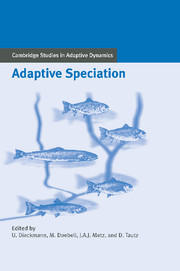Book contents
- Frontmatter
- Contents
- Contributing Authors
- Acknowledgments
- Notational Standards
- 1 Introduction
- 2 Speciation in Historical Perspective
- A Theories of Speciation
- B Ecological Mechanisms of Speciation
- 8 Speciation and Radiation in African Haplochromine Cichlids
- 9 Natural Selection and Ecological Speciation in Sticklebacks
- 10 Adaptive Speciation in Northern Freshwater Fishes
- 11 Sympatric Speciation in Insects
- 12 Adaptive Speciation in Agricultural Pests
- 13 Ecological Speciation in Flowering Plants
- 14 Experiments on Adaptation and Divergence in Bacterial Populations
- C Patterns of Speciation
- References
- Index
9 - Natural Selection and Ecological Speciation in Sticklebacks
Published online by Cambridge University Press: 05 July 2014
- Frontmatter
- Contents
- Contributing Authors
- Acknowledgments
- Notational Standards
- 1 Introduction
- 2 Speciation in Historical Perspective
- A Theories of Speciation
- B Ecological Mechanisms of Speciation
- 8 Speciation and Radiation in African Haplochromine Cichlids
- 9 Natural Selection and Ecological Speciation in Sticklebacks
- 10 Adaptive Speciation in Northern Freshwater Fishes
- 11 Sympatric Speciation in Insects
- 12 Adaptive Speciation in Agricultural Pests
- 13 Ecological Speciation in Flowering Plants
- 14 Experiments on Adaptation and Divergence in Bacterial Populations
- C Patterns of Speciation
- References
- Index
Summary
Introduction
The idea that selection may be fundamental to the origin of species dates back at least to the synthesis of modern evolutionary theory, being present in the writings of Fisher (1930), Muller (1942), and Dobzhansky (1951). Nevertheless, despite almost three-quarters of a century since the idea was first proposed, little progress has been made in testing the role of selection in speciation (Coyne 1992; Schluter 1996a, 2001; Futuyma 1998). As the various chapters of this volume attest, however, the topic is enjoying a resurgence of interest (see also Schluter 2001). The purpose of this chapter is to summarize tests for the role of selection in speciation in a natural system: the sympatric populations of limnetic and benthic threespine sticklebacks that inhabit postglacial lakes in British Columbia, Canada (Plate 2). Our investigation specifically addresses the role of divergent selection between environments and niches in the origin of reproductive isolation, and the role of reinforcement in its completion. Throughout, we adopt Mayr's (1942) biological species concept, in which species are groups of actually or potentially interbreeding natural populations that are isolated reproductively from other such groups. We broaden this definition slightly to recognize that imperfect reproductive isolation can exist between species that nevertheless maintain their distinctiveness in nature (Rundle et al. 2001).
- Type
- Chapter
- Information
- Adaptive Speciation , pp. 192 - 209Publisher: Cambridge University PressPrint publication year: 2004
- 46
- Cited by



